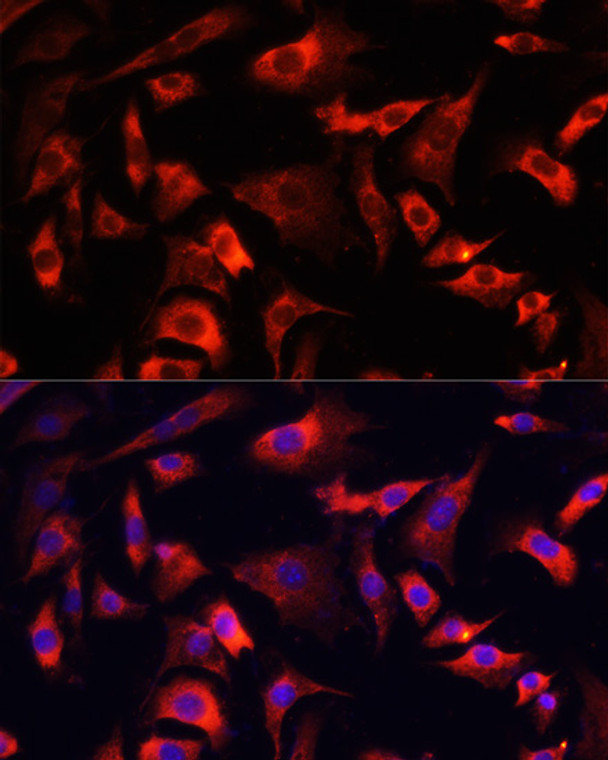| Host: |
Rabbit |
| Applications: |
WB/IF |
| Reactivity: |
Human/Mouse/Rat |
| Note: |
STRICTLY FOR FURTHER SCIENTIFIC RESEARCH USE ONLY (RUO). MUST NOT TO BE USED IN DIAGNOSTIC OR THERAPEUTIC APPLICATIONS. |
| Short Description: |
Rabbit polyclonal antibody anti-FXR1 (310-539) is suitable for use in Western Blot and Immunofluorescence research applications. |
| Clonality: |
Polyclonal |
| Conjugation: |
Unconjugated |
| Isotype: |
IgG |
| Formulation: |
PBS with 0.01% Thimerosal, 50% Glycerol, pH7.3. |
| Purification: |
Affinity purification |
| Dilution Range: |
WB 1:500-1:2000IF/ICC 1:50-1:200 |
| Storage Instruction: |
Store at-20°C for up to 1 year from the date of receipt, and avoid repeat freeze-thaw cycles. |
| Gene Symbol: |
FXR1 |
| Gene ID: |
8087 |
| Uniprot ID: |
FXR1_HUMAN |
| Immunogen Region: |
310-539 |
| Immunogen: |
Recombinant fusion protein containing a sequence corresponding to amino acids 310-539 of human FXR1 (NP_001013456.1). |
| Immunogen Sequence: |
KSGVVRVRIEGDNENKLPRE DGMVPFVFVGTKESIGNVQV LLEYHIAYLKEVEQLRMERL QIDEQLRQIGSRSYSGRGRG RRGPNYTSGYGTNSELSNPS ETESERKDELSDWSLAGEDD RDSRHQRDSRRRPGGRGRSV SGGRGRGGPRGGKSSISSVL KDPDSNPYSLLDNTESDQTA DTDASESHHSTNRRRRSRRR RTDEDAVLMDGMTESDTASV NENGLGKRCD |
| Tissue Specificity | Expressed in all tissues examined including heart, brain, kidney and testis. In brain, present at high level in neurons and especially in the Purkinje cells at the interface between the granular layer and the molecular layer (at protein level). |
| Post Translational Modifications | Phosphorylation at Ser-420 by PAK1 promotes its relocalization to stress granules and activity. Phosphorylated by MAPK1/ERK2, promoting subsequent phosphorylation by GSK3B. Phosphorylated by GSK3B, promoting ubiquitination and degradation by the proteasome. Ubiquitinated by the SCF(FBXO4) complex, leading to its degradation by the proteasome: ubiquitination by the SCF(FBXO4) complex takes place following phosphorylation by GSK3B. Ubiquitinated and degraded in a GSK3B-dependent manner in during both scaling and sleep deprivation. Ubiquitinated via 'Lys-63'-linked ubiquitin, leading to its degradation: interaction with CEP63 inhibits 'Lys-63'-linked ubiquitination. |
| Function | mRNA-binding protein that acts as a regulator of mRNAs translation and/or stability, and which is required for various processes, such as neurogenesis, muscle development and spermatogenesis. Specifically binds to AU-rich elements (AREs) in the 3'-UTR of target mRNAs. Promotes formation of some phase-separated membraneless compartment by undergoing liquid-liquid phase separation upon binding to AREs-containing mRNAs, leading to assemble mRNAs into cytoplasmic ribonucleoprotein granules that concentrate mRNAs with associated regulatory factors. Required to activate translation of stored mRNAs during late spermatogenesis: acts by undergoing liquid-liquid phase separation to assemble target mRNAs into cytoplasmic ribonucleoprotein granules that recruit translation initiation factor EIF4G3 to activate translation of stored mRNAs in late spermatids. Promotes translation of MYC transcripts by recruiting the eIF4F complex to the translation start site. Acts as a negative regulator of inflammation in response to IL19 by promoting destabilization of pro-inflammatory transcripts. Also acts as an inhibitor of inflammation by binding to TNF mRNA, decreasing TNF protein production. Acts as a negative regulator of AMPA receptor GRIA2/GluA2 synthesis during long-lasting synaptic potentiation of hippocampal neurons by binding to GRIA2/GluA2 mRNA, thereby inhibiting its translation. Regulates proliferation of adult neural stem cells by binding to CDKN1A mRNA and promoting its expression. Acts as a regulator of sleep and synaptic homeostasis by regulating translation of transcripts in neurons. Required for embryonic and postnatal development of muscle tissue by undergoing liquid-liquid phase separation to assemble target mRNAs into cytoplasmic ribonucleoprotein granules. Involved in the nuclear pore complex localization to the nuclear envelope by preventing cytoplasmic aggregation of nucleoporins: acts by preventing ectopic phase separation of nucleoporins in the cytoplasm via a microtubule-dependent mechanism. |
| Protein Name | Rna-Binding Protein Fxr1Fmr1 Autosomal Homolog 1Hfxr1p |
| Database Links | Reactome: R-HSA-6802952 |
| Cellular Localisation | CytoplasmCytoplasmic Ribonucleoprotein GranuleStress GranuleCell ProjectionDendriteDendritic SpineAxonNucleus EnvelopePostsynapseSpecifically Localizes To Cytoplasmic Ribonucleoprotein Membraneless CompartmentsLocalizes To Stress Granules Following Phosphorylation At Ser-420 By Pak1Adjacent To Z-Lines In Muscles |
| Alternative Antibody Names | Anti-Rna-Binding Protein Fxr1 antibodyAnti-Fmr1 Autosomal Homolog 1 antibodyAnti-Hfxr1p antibodyAnti-FXR1 antibody |
Information sourced from Uniprot.org
12 months for antibodies. 6 months for ELISA Kits. Please see website T&Cs for further guidance









